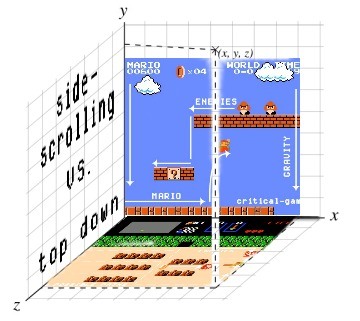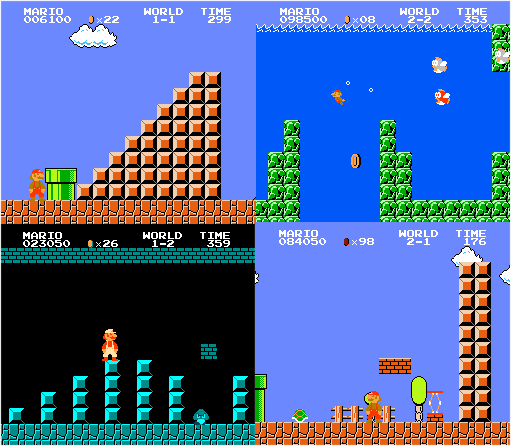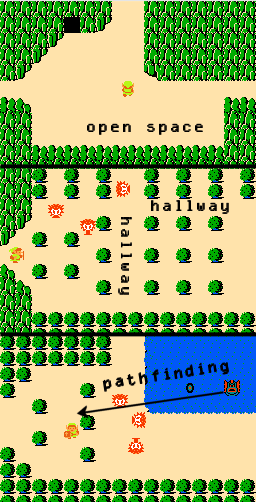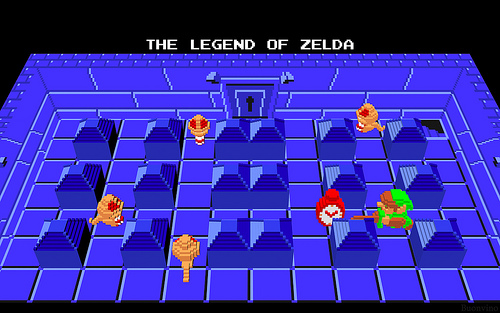2D + 2D = 3D pt.1
 Sunday, February 22, 2009 at 10:21AM
Sunday, February 22, 2009 at 10:21AM Understanding the design and dynamics of 3D space requires a solid understanding of 2D space. While the 3rd dimension adds another layer to into the system compared to the 2nd dimension, understanding how video games use this additional layer is a matter of understanding the dynamics of space and gravity.
3D space is made up of 3 axes: X, Y, Z. The first step to understanding how video games work in 3D is to look at how they work in 2D. If you take away any one axis of a 3D game, you'll either have a 2D side-scrolling game or a top down game.

For the purposes of this article series and the Critical-Gaming blog, a side-scroller means more than a game featuring a graphical style that moves horizontally. More specifically, a 2D side-scroller applies to games that are viewed from the side. The side is relative to the direction the gravity in the game is pulling. Let's look at Super Mario Brothers for an example of a 2D side scrolling game.
2D Side-scrolling
Because the gravity is constantly pulling the player, Mario, to the ground most of the significant actions in Super Mario Brothers occur along and/or near the ground. This simple dynamic helps simplify the design of Super Mario Brothers. After designing the basics of the player mechanics and the 2D side-scrolling game world, creating enemies with contrary motion is easy. The lowly Goomba is such an effective enemy not just because of its interplay, but because it influences the player to JUMP and maneuver around it just by slowly walking to the left along the ground at an even pace. In fact, about half of the land enemies in Super Mario Brothers are are affected by gravity and therefore travel along the ground/platforms. In this way, the gameplay is focused to the areas along the ground which reduces the amount of screen the player needs to process actively to play effectively.

The white lines represent the paths I took in 3 separate playthroughs.
Notice how they all hug the level elements because of gravity.
In a 2D side scrolling game like Super Mario Brothers, the z axis (depth) is interpreted. Technically and functionally, there is no 3rd dimension in SMB. However, as Mario runs around we can easily interpret the non interactive background elements (blue sky, green bushes, clouds, etc.) as existing far away from Mario. Every time two visual elements pass through/over each other without colliding, we interpret their positions as being separate along that Z axis. For example, when the Bullet Bills pass through solid level elements we interpret the Bullet Bills as curving around those elements. In this way, they can "pass through" solid objects yet still hit Mario.

This is sort of how we think of it in our heads.
Finally, the 2D side view of games like Super Mario Brothers invites players to explain and rationalize more abstract visuals. For example, have you ever thought about how or why the bricks in Mario Bros. float in mid air? Perhaps we've all gotten used to imaginative world of Super Mario and we easily accept such abnormalities. However, all 2D side scrolling games with 2D visuals share this same quality. Instinctively, we understand that because we're looking into a 2D world through a 2D TV screen, that we are to interpret the visuals as a vertical slice of the game world. So, the floating bricks in Mario aren't necessarily floating around in mid air. Because we can't swing the camera around to investigate we can't prove whether or not the bricks are connected to a surface that's behind the bricks or behind the "camera" through which we view the game. Because this significant level of interpretation exists, we interpret the 2D structures of Super Mario Brothers not as floating bricks, but stairs, underwater chasms, stalagmites, towers (see below), and other structures. It truly takes an artistic touch to be able to arrange a few blocks/level elements to communicate a wide variety of structures.

2D Top Down
Instead of using an axis aligned with the pull of gravity, 2D top down games use two axes along the ground. In other words, instead of using gravity as a core dynamic, top down games simply use space which inherently makes top down games much more complicated.
Gravity is great for keeping the gameplay focused along the ground or along platforms. Without gravity, like in top down 2D games, the payer is free to move about the game world/field any way they want with little to no restrictions. When you JUMP in Super Mario Bros. you can only adjust your height by holding the button longer. After you let go, Mario goes into a sort of free fall where he can only influence his horizontal position. In a top down game like the The Legend of Zelda for the NES, you can move to any "height" or position on the screen and stay there indefinitely. Movement in this way isn't dynamic.
Because the player can move about the field freely, creating enemies with contrary motion that influences the player is much more complicated. Most top down games rely on two techniques to limit the available space and thus influence the player; putting lots of of enemy/level elements on the screen and/or using a lot of pathfinding.
The Legend of Zelda breaks up the open space on the screen with blocks and other level elements that force players and enemies to maneuver around them. Zelda also puts a number of enemies on the screen that patrol around. Finally, enemies like the River Zora shoot out blastS that are aimed at Link. The aiming in this case is an example of the most basic kind of pathfinding where after the initial direction is adjusted at the target, then the projectile travels in a straight line. These three measures all work to confine the free, open space available to the player so that the player eventually must commit to his/her actions or be cornered by the counterpoint of opposing game elements.

The level elements break up the space when sparely used. When lined up, they create corridors or hallways. Hallways are effective at restricting motion because they generally only have few entrances and exits. When fleeing enemies or simply trying to move across the overworld in Zelda, you may enter one of these hallways only to have the other end blocked off by an enemy or projectile. At this point, the player must choose to take damage running through the enemies, stand and fight, or try to wait things out. All of these options are more interesting and are more threatening than simply avoiding enemies by running away from them all over an open space.
The patrolling Octorok (seen left) have more complex behavior/movement patterns than all the enemies from Super Mario Brothers. The options in the AI design of an Octorok include rotate, move (up, down, left, right), stand still, and shoot rock. This not to mention that these enemies randomly spawn as either a fast or slow speed type. Comparing the Octorok to the Goomba, the basic enemies from Mario and Zelda, highlights the inherent differences in design between side-scrolling and top down 2D games. Because the core dynamic of the 2D side-scrollers is gravity, the simple Goomba enemy design can have a significant influence on players by forcing them to JUMP and thus engage with gravity. Comparatively, the engaging dynamic in Zelda doesn't inherently come from moving about the game world. Instead, the dynamic comes from how the open spaces are limited by the random actions of the complex enemies. The more enemies, the more complex the battle field becomes.
With top down 2D games, the Y axis (upward) is left up to the player's interpretation. With a birds eye view of the game world, it can be difficult to impossible to judge the height of characters, enemies, projectiles, or level elements. In the same way that we interpret when two objects pass through each other in 2D side-scroller as depth (Z axis), we interpret two objects passing through each other as height (y axis) with 2D top down visuals. In this way, we interpret the River Zora attacks that move in a straight line across the whole screen as flying above the enemies and level objects only landing on top of Link's head in the event that the projectile crosses Link's path. The energy blast that Link shoots from his sword when at full health passes through various level elements. I interpret this energy attack like a mechanic wave that has the ability to be absorbed by some matter and transmitted. Of course enemies aren't strong enough to transmit the energy, so they die. Function influencing artistic interpretation is an interesting part of the art of video games.

This image renders the top down view of Zelda with more verticality.
In part 2, I'll go over several examples of 2D side scrolling and top down games as well as a few examples that fit somewhat in both categories.


Reader Comments (4)
I'm interested in seeing where this goes. Especially if you can show comparisons between these two types of 2D and 3D gameplay.
Very Interesting !!! Congratulations
I think it would be interesting to also talk about multi-plane side scrollers like Yoshi's Story or Little Big Planet.
@chiffmonkey
That is an interesting topic that's trickier than it may seem.
For some examples, like in Yoshi's Story, a branching path doesn't create any kind of 3D space. Rather, it's simply a neat way of displaying an alternate path.
I talk about the punctuated 3D of LittleBigPlanet later in this series.